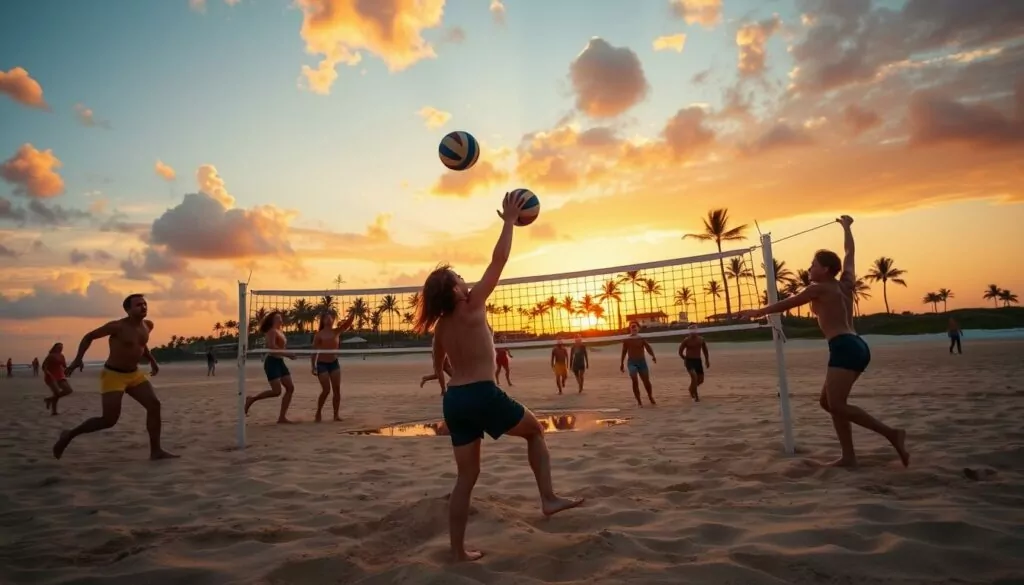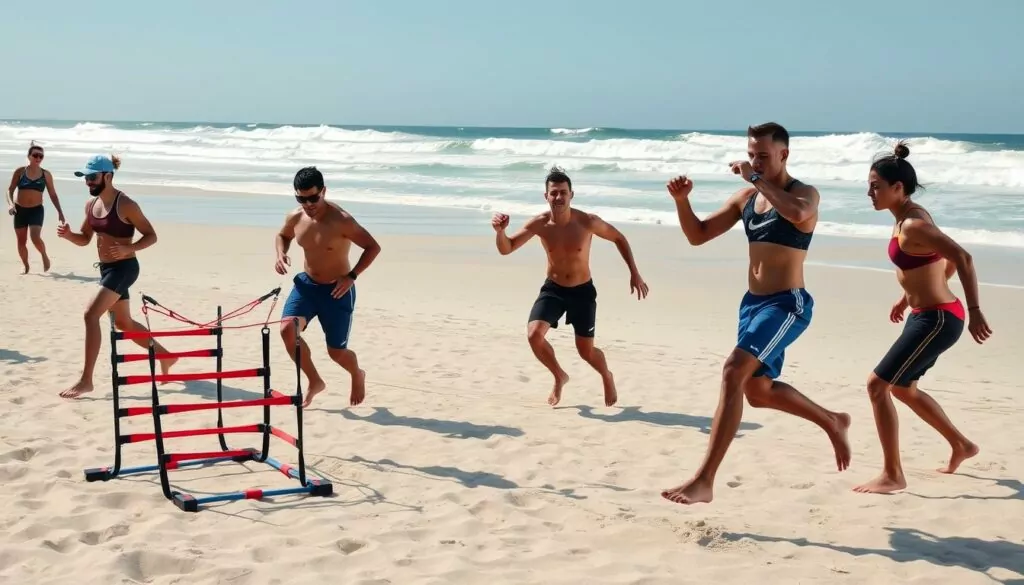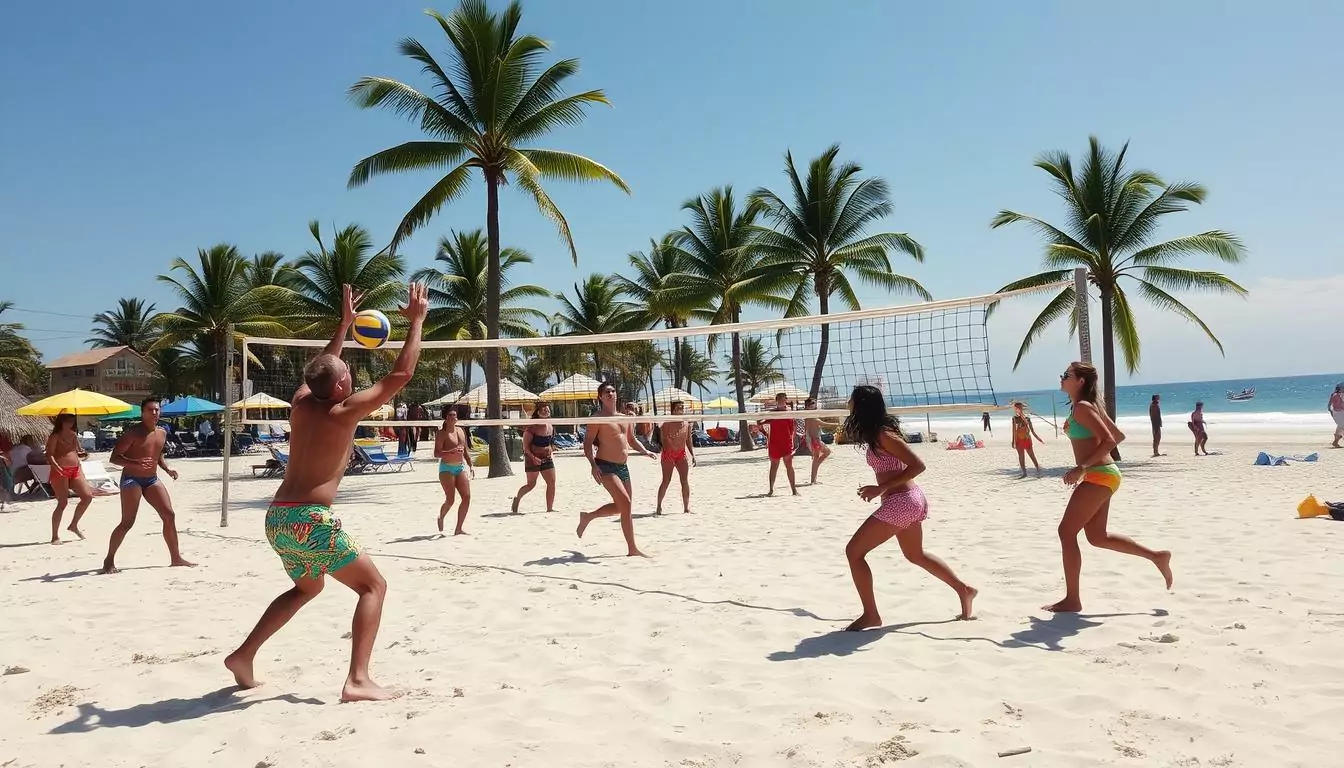I’ll never forget the day I first stepped onto the sun-warmed sand, volleyball in hand, ready to take on the world. The ocean breeze carried the scent of salt and sunscreen, and the sound of laughter mixed with the rhythmic crash of waves. That moment sparked a lifelong passion for beach volleyball that I’m excited to share with you today.
As I’ve honed my skills over the years, I’ve discovered that success in beach volleyball isn’t just about raw talent. It’s about mastering techniques, understanding strategies, and constantly refining your game. Whether you’re a newcomer or a seasoned player looking to up your game, I’ve got some beach volleyball tips that will help you shine on the sand.
From serving techniques that’ll keep your opponents on their toes to communication strategies that’ll make you and your partner an unstoppable duo, we’ll cover it all. Get ready to dive into the world of beach volleyball and emerge with the skills to dominate your next match.
Key Takeaways
- Master fundamental beach volleyball techniques
- Learn effective serving and passing strategies
- Improve communication with your partner
- Develop a strong fitness routine for endurance
- Analyze opponents and create winning game plans
- Stay motivated and positive during matches
Understand the Fundamentals of Beach Volleyball

Beach volleyball is an exciting sport that combines athleticism, strategy, and teamwork. As a beach volleyball coach, I’ve seen how mastering the basics can significantly improve a player’s performance. Let’s dive into the essential rules and positions that form the foundation of this dynamic game.
Learn the Basic Rules of the Game
Beach volleyball follows a straightforward scoring system. Teams compete to win two out of three sets, with each set played to 21 points. A team must win by two points, and if a third set is needed, it’s played to 15 points. Understanding these rules is crucial for developing effective beach volleyball skills.
The court dimensions in beach volleyball are smaller than indoor volleyball, measuring 16 x 8 meters. This compact size demands quick reflexes and precise movements from players. Each team is allowed up to three touches to return the ball over the net, with no player hitting the ball twice in succession.
Master the Positions on the Court
In beach volleyball, there are only two players per team on the court. This creates a unique dynamic where each player must be versatile and skilled in all aspects of the game. The two main positions are:
- Left-side player: Often responsible for receiving serves and attacking from the left side
- Right-side player: Usually takes on the bulk of setting duties and blocks on the right side
Effective beach volleyball coaching emphasizes the importance of both players being able to perform all skills. This versatility allows teams to adapt their strategies based on their opponents’ weaknesses and the ever-changing conditions of outdoor play.
| Skill | Left-side Player | Right-side Player |
|---|---|---|
| Serving | Primary server | Secondary server |
| Passing | Main passer | Support passer |
| Setting | Emergency setter | Primary setter |
| Hitting | Left-side attacker | Right-side attacker |
| Blocking | Left-side blocker | Right-side blocker |
Improve Your Skills with Effective Drills

I’ve found that beach volleyball drills are essential for honing your skills on the sand. Let’s dive into some effective exercises that will elevate your game.
Focus on Serving Techniques
Beach volleyball serving is a crucial skill to master. I practice the following drill to improve my serve accuracy:
- Set up targets on the opposite court
- Serve 10 balls, aiming for different spots each time
- Keep track of successful hits and try to beat your record
Practice Passing and Setting
Consistent passing and setting form the backbone of beach volleyball training. Here’s a drill I use to sharpen these skills:
- Stand 15 feet apart from your partner
- Pass the ball back and forth 20 times without letting it drop
- Move 5 feet further apart and repeat
- Continue until you reach the full court length
Enhance Your Communication with Partners
Clear communication is vital in beach volleyball. Try this drill to boost your on-court connection:
| Drill Step | Player 1 Action | Player 2 Action |
|---|---|---|
| 1 | Toss ball over the net | Call “Mine” or “Yours” |
| 2 | React based on call | Play the ball if called |
| 3 | Set for attack | Call hit type (Line/Cut) |
| 4 | Execute called hit | Cover the court |
By incorporating these beach volleyball drills into your routine, you’ll see significant improvements in your serving, passing, setting, and communication skills.
Fitness and Conditioning for Beach Volleyball

Beach volleyball conditioning plays a crucial role in achieving peak performance on the sand. I’ve found that a well-rounded fitness routine can significantly improve your game. Let’s dive into some key areas to focus on for optimal beach volleyball conditioning.
Build Endurance for Longer Matches
Endurance is vital in beach volleyball. I recommend incorporating high-intensity interval training (HIIT) into your workouts. This type of training mimics the stop-and-start nature of the game. Try alternating between 30 seconds of intense exercise and 30 seconds of rest for 15-20 minutes.
Strengthen Your Core and Legs
A strong core and powerful legs are essential for beach volleyball footwork. I’ve seen great results with exercises like planks, Russian twists, and squats. Here’s a sample workout routine to get you started:
| Exercise | Sets | Reps |
|---|---|---|
| Planks | 3 | 30 seconds |
| Russian Twists | 3 | 20 each side |
| Squats | 3 | 15 |
| Lunges | 3 | 10 each leg |
Remember, proper beach volleyball footwork is crucial for quick movements on the sand. Practice lateral shuffles, crossover steps, and quick direction changes to improve your agility. By focusing on these fitness and conditioning aspects, you’ll be well-prepared for those intense matches under the sun.
Strategies for Winning Matches
I’ve got some game-changing beach volleyball strategies to help you dominate the sand. These tips will boost your performance and give you an edge over your opponents.
Develop a Strong Game Plan
Creating a solid game plan is key to success. Before each match, I suggest discussing tactics with your partner. Focus on your strengths and plan how to exploit your opponents’ weaknesses. This approach will help you stay organized and make smart decisions during play.
Analyze Your Opponents’ Weaknesses
Watching your opponents closely can reveal their weak spots. Look for patterns in their serve, set, or spike techniques. Once you spot these weaknesses, adjust your beach volleyball strategies to target them. This tactic can give you a significant advantage during the game.
Stay Positive and Motivated
Keeping a positive attitude is crucial in beach volleyball. I always remind myself to stay upbeat, even when facing tough situations. Encourage your partner and celebrate small victories. This positive energy can help you maintain focus and improve your beach volleyball techniques throughout the match.
